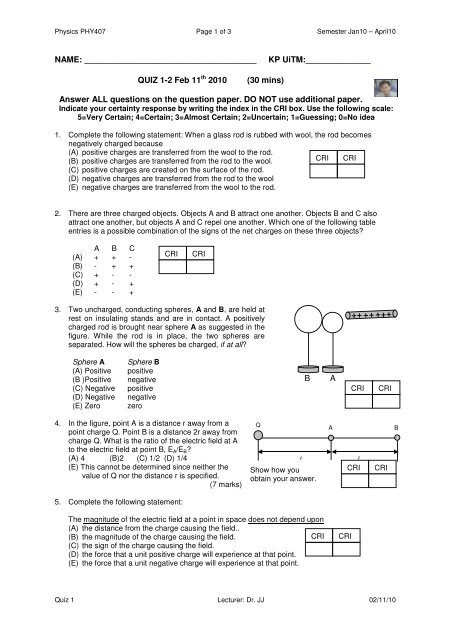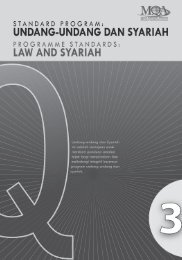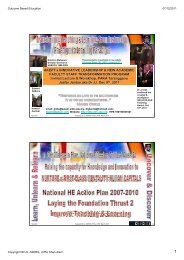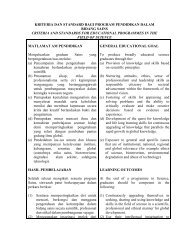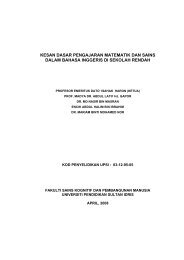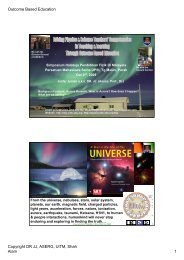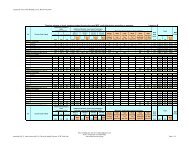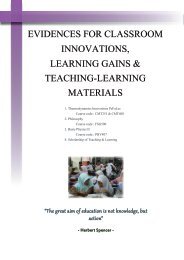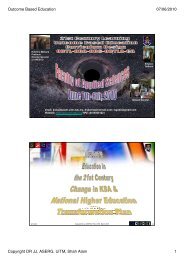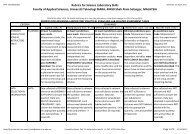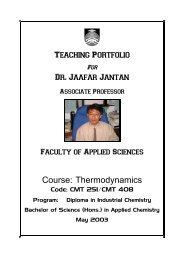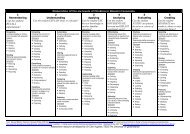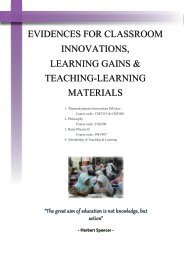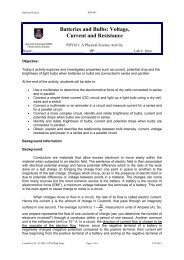QUIZ 1-2 Feb 11th 2010 - DrJJ - UiTM
QUIZ 1-2 Feb 11th 2010 - DrJJ - UiTM
QUIZ 1-2 Feb 11th 2010 - DrJJ - UiTM
You also want an ePaper? Increase the reach of your titles
YUMPU automatically turns print PDFs into web optimized ePapers that Google loves.
Physics PHY407 Page 1 of 3 Semester Jan10 – April10<br />
NAME: _____________________________________<br />
KP <strong>UiTM</strong>:______________<br />
<strong>QUIZ</strong> 1-2 <strong>Feb</strong> 11 th <strong>2010</strong><br />
(30 mins)<br />
Answer ALL questions on the question paper. DO NOT use additional paper.<br />
Indicate your certainty response by writing the index in the CRI box. Use the following scale:<br />
5=Very Certain; 4=Certain; 3=Almost Certain; 2=Uncertain; 1=Guessing; 0=No idea<br />
1. Complete the following statement: When a glass rod is rubbed with wool, the rod becomes<br />
negatively charged because<br />
(A) positive charges are transferred from the wool to the rod.<br />
(B) positive charges are transferred from the rod to the wool.<br />
(C) positive charges are created on the surface of the rod.<br />
(D) negative charges are transferred from the rod to the wool<br />
(E) negative charges are transferred from the wool to the rod.<br />
CRI CRI<br />
2. There are three charged objects. Objects A and B attract one another. Objects B and C also<br />
attract one another, but objects A and C repel one another. Which one of the following table<br />
entries is a possible combination of the signs of the net charges on these three objects<br />
A B C<br />
(A) + + -<br />
(B) - + +<br />
(C) + - -<br />
(D) + - +<br />
(E) - - +<br />
CRI<br />
CRI<br />
3. Two uncharged, conducting spheres, A and B, are held at<br />
rest on insulating stands and are in contact. A positively<br />
charged rod is brought near sphere A as suggested in the<br />
figure. While the rod is in place, the two spheres are<br />
separated. How will the spheres be charged, if at all<br />
Sphere A<br />
(A) Positive<br />
(B )Positive<br />
(C) Negative<br />
(D) Negative<br />
(E) Zero<br />
Sphere B<br />
positive<br />
negative<br />
positive<br />
negative<br />
zero<br />
B<br />
A<br />
CRI<br />
CRI<br />
4. In the figure, point A is a distance r away from a<br />
point charge Q. Point B is a distance 2r away from<br />
charge Q. What is the ratio of the electric field at A<br />
to the electric field at point B, E A /E B <br />
(A) 4 (B)2 (C) 1/2 (D) 1/4<br />
(E) This cannot be determined since neither the<br />
value of Q nor the distance r is specified.<br />
(7 marks)<br />
Q<br />
Show how you<br />
obtain your answer.<br />
r<br />
A<br />
r<br />
CRI<br />
CRI<br />
B<br />
5. Complete the following statement:<br />
The magnitude of the electric field at a point in space does not depend upon<br />
(A) the distance from the charge causing the field..<br />
(B) the magnitude of the charge causing the field.<br />
CRI<br />
(C) the sign of the charge causing the field.<br />
(D) the force that a unit positive charge will experience at that point.<br />
(E) the force that a unit negative charge will experience at that point.<br />
CRI<br />
Quiz 1 Lecturer: Dr. JJ 02/11/10
Physics PHY407 Page 2 of 3 Semester Jan10 – April10<br />
6. A hollow metal sphere is electrically neutral (no excess charge). A small amount of negative<br />
charge is suddenly placed at one point, P, on this metal sphere. If we check on this excess<br />
negative charge a few seconds later we will find one of the following possibilities:<br />
(A) All of the excess charge remains right around P.<br />
(B) The excess charge has distributed itself evenly over the outside surface of<br />
the sphere.<br />
(C) Most of the charge is still at P, but some will have spread over the sphere<br />
(D) The excess charge is evenly distributed over the inside and outside surface.<br />
(E) There will be no excess charge left.<br />
CRI<br />
CRI<br />
7. A hollow sphere made out of electrically insulating material is electrically neutral (no excess<br />
charge). A small amount of negative charge is suddenly placed at one point, P, on the outside of<br />
this sphere. If we check on this excess negative charge a few seconds later we will find one of the<br />
following possibilities:<br />
(A) All of the excess charge remains right around P.<br />
(B) The excess charge has distributed itself evenly over the outside surface of<br />
the sphere.<br />
(C) Most of the charge is still at P, but some will have spread over the sphere.<br />
(D) The excess charge is evenly distributed over the inside and outside surface.<br />
(E) There will be no excess charge left.<br />
CRI<br />
CRI<br />
For questions 8 -10:<br />
Two small objects shown in Figure 1 each having a net charge of -Q exert a force of magnitude F on<br />
each other.<br />
F<br />
-Q -Q<br />
Figure 1<br />
F<br />
We replace one of the objects with another object with net charge of +3Q as shown in Figure 2.<br />
+3Q Q<br />
Figure 2<br />
8. The original magnitude of the force on the -Q charge was F. What is the magnitude of the force<br />
on the -Q now Show how you obtain your answer.<br />
CRI CRI<br />
(A) 2F (B) F (C) zero (D) F/2 (E) other<br />
Next we move the -Q and -2Q charges so that their separation is now 3 times as far apart as they<br />
were before as shown in Figure 3.<br />
+3Q Q<br />
Figure 3<br />
9. What is the magnitude of the force on the -Q now<br />
(A) F/9 (B) F/3 (C) 4F/9<br />
(D) 4F/3 (E) other<br />
Show how you obtain your answer.<br />
CRI<br />
CRI<br />
Quiz 1 Lecturer: Dr. JJ 02/11/10
Physics PHY407 Page 3 of 3 Semester Jan10 – April10<br />
10. Which of the arrows is in the direction of the net force on charge B shown in Figure 4<br />
(a)<br />
(d)<br />
(b) (e) None of these<br />
(c)<br />
CRI<br />
CRI<br />
11. Figure 5 shows a particle (labeled B) which has a net electric<br />
charge of +1 unit. Several centimeters to the left is another<br />
particle (labeled A) which has a net charge of -2 units. Choose<br />
the pair of force vectors (the arrows) that correctly compare the<br />
electric force on A (caused by B) with the electric force on B<br />
(caused by A).<br />
-1 units +1 units<br />
A<br />
Figure 4<br />
-2 units +3 unit<br />
A<br />
B<br />
Figure 5<br />
+1 units<br />
C<br />
B<br />
(A)<br />
(B)<br />
(C)<br />
Force on A Force on B Force on A Force on B CRI CRI<br />
(D)<br />
(E)<br />
Y<br />
Y<br />
12. In Figure 6a, negative charges q 2 and q 3<br />
exert on charge q 1 a net electric force<br />
that points along the +x axis. If a positive<br />
charge Q is added at (b, 0) as shown in<br />
Figure 6b, what will happen to the force<br />
on q 1 (All charges are fixed at their<br />
locations.)<br />
q 1<br />
-q 2<br />
-q 3<br />
X<br />
q 1<br />
-q 2<br />
-q 3<br />
-Q<br />
(b, 0)<br />
X<br />
(A) No change in the size of the net<br />
Figure 6a<br />
Figure 6b<br />
force since Q is on the x-axis.<br />
(B) The size of the net force will change but not the direction.<br />
CRI CRI<br />
(C) The net force will decrease and the direction may change because of the<br />
interaction between Q and the positive charge q 2 and q 3.<br />
(D) The net force will increase and the direction may change because of the interaction between<br />
Q and the positive charge q 2 and q 3 .<br />
(E) Cannot determine without knowing the magnitude of q 1 and/or Q.<br />
13. In Figure 7a, the electric field at point P is<br />
directed downward along the y-axis. If a negative<br />
charge –Q is added at a point along the y-axis as<br />
shown in Figure 7b, what happens to the field at<br />
P (All charges are fixed in position)<br />
before<br />
+q +q<br />
(A) Nothing since –Q is on the y-axis.<br />
(B) The strength will increase because Q is<br />
negative.<br />
P<br />
CRI CRI<br />
P<br />
(C) The strength will decrease and the direction<br />
may change because of the interactions<br />
between Q and the two negative q’s.<br />
Figure 7a<br />
Figure 7b<br />
(D) The strength will increase and the direction may change because of the interactions between<br />
Q and the two negative q’s.<br />
(E) Cannot determine without knowing the force that Q exerts on the two negative q’s.<br />
Y<br />
X<br />
after<br />
Y<br />
-Q<br />
+q +q<br />
X<br />
Quiz 1 Lecturer: Dr. JJ 02/11/10


